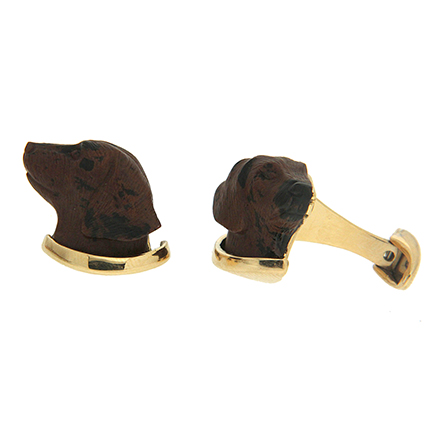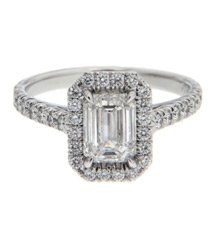Shirts were originally worn to protect outer garments from perspiration and other things, as well as to prevent chafing. Depending on the era, shirts were completely hidden from view, or elements such as collars and cuffs peeked through. Visible portions were more likely to be embellished.
Cufflinks are detachable accessories designed for shirt cuffs with buttonholes yet no buttons. They are designed to allow enough flexibility to be easily inserted, yet rigid enough to keep the shirt secure. As an accessory, cufflinks can be mass produced casual items, or high end works of art.
History
During the eighteenth century, shirt cuffs were secured with ties or buttons. Members of the elite might use elaborate fasteners of precious materials to serve as both decoration and function. By the nineteenth century, the rise of the middle class allowed more people to spend money on adornment. Victorian men’s clothing emphasized dark colors and sobriety, with subtle flourishes such as pretty cuffs.
By 1850, shirt cuffs were designed to be stiff and further reinforced with starch. This helped protect them from wear, but made buttoning them increasingly difficult. Cufflinks were created as a way to close sleeves with minimal difficulty. Even as sleeve designs changed to be easier to handle, cufflinks persisted.
Cufflinks were initially made as discrete pieces which blended in with the rest of the shirt. When he was still the Prince of Wales, British king Edward VII began wearing colorful versions designed by top jewelers of the time. Others emulated this flashier style, with some favoring mass produced pieces of affordable glass and enamel, while others donned cufflinks of jewels and gold.
As with other jewelry, cufflinks echoed the design aesthetics of when they were made. Early 20th century pieces followed Edwardian trends for neutral colored designs, Art Nouveau cufflinks favored gold and curved imagery, and so on. The accessory saw a decline as casual clothing gained prominence, but experienced a revival among those who enjoy formal wear.
Styles
Among the simplest cufflinks are those made from two pieces of knotted cord held together with elastic. Other designs feature a decorative element on one end and a toggle on the other, connected with a bar. Still more sport two motifs held together with links. The latter version may have coordinating or contrasting designs.
Cufflinks are worn in different ways. French style cuffs are fastened with the inner sides touching one another, creating a pear shape when viewed from the side. Barrel cuffs have their ends overlap before they’re secured, creating a circle. Depending on the style and materials, heirloom cufflinks may be repurposed into other jewelry such as earrings.
Materials Used
At their simplest, cufflinks may be made of knotted silk, elastic, glass or other affordable materials. At their most elaborate, they can be made of gold encrusted with diamonds, pearls and other precious stones. Less conventional materials may include leather, antique coins, and even recycled watch pieces.
Motifs
 Whether it be fabric, silver or gold, knots make an attractive element for cufflinks. These motifs are more likely to be three dimensional rather than flat, with rounded shapes. Common versions include the monkey’s fist, which consists of three rows of cord looped together to create a ball. Another popular knot style is the Turk’s head, which resembles a multi strand braid forming a closed loop.
Whether it be fabric, silver or gold, knots make an attractive element for cufflinks. These motifs are more likely to be three dimensional rather than flat, with rounded shapes. Common versions include the monkey’s fist, which consists of three rows of cord looped together to create a ball. Another popular knot style is the Turk’s head, which resembles a multi strand braid forming a closed loop.
Geometric cufflink design can be three dimensional, flat, plain metal or highlighted with jewels. Simpler versions can be square, round, rectangular or shaped like a bar. Outlines can be elaborated with borders, stripes of enamel or precious metal, wheel-like spokes or checkerboard imagery. Shapes may also be layered on top of one another such as triangles over two ends of a rectangle.
Animal style cufflinks have been popular since the Victorian era. While older versions evoked hunting and related activities, today’s connoisseurs may wear animal motifs to express a love of nature, traveling or other concepts. Designs like seashells for example may bring the beach to mind. Jewels fashioned into dog’s heads may symbolize loyalty, and frogs a sense of playfulness.
Cufflinks with a personalized touch are also popular. This could be as simple as a set in one’s favorite color. Another way to give cufflinks a custom touch is having one’s monogram engraved on them. Elaborated versions may include the wearer’s birthstone or other embellishments with special meanings.
Coordinating
During the Victorian period, men were expected to dress in sober attire. Jewelry such as necklaces, bracelets and earrings weren’t encouraged. Accessories for men took a subtler route, such as shirt studs, watch chains and scarf pins. Cufflinks served as another element of the well-dressed man’s ensemble.
By the mid-20th century, different types of jewelry were considered manly. Watch chains were replaced by wrist watches, and tie pins, money clips and cigarette cases were popular accessories. Cufflinks served as a common thread between these two eras and tastes, helping to finish a stylish outfit.
Today’s person may wear as they please, be it formal or everyday attire. Cufflinks can be worn as a subtle touch for someone who wants to put together a matching jewelry set, but would like something a little unusual. They pair well with shirt studs, but may also be coordinated with brooches, rings or whatever else the wearer desires.





